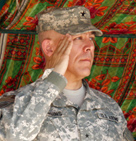BPC and the Indirect vs. Direct Approach in The Long War
By Major Rob Thornton
Some time ago I began to consider how our various efforts in the Long War are linked. Many on the Small Wars Council (SWC) have slogged through this with me on threads such as "Stability Operations vs. Irregular Warfare", and many other threads in which we try to establish the linkages between strategy to operations to tactics, or in which we consider policy.
Part of what a "strategist" (and I use the term loosely!) tries to do is to understand and relate the writing, speeches and statements of our elected and appointed officials to our efforts -- or how our policy objectives get implemented into some type of action to realize them. Army strategists are taught the Ends, Way & Means formula, but they are also taught to consider other perspectives on strategy such as if a strategy is complete, feasible, acceptable, and suitable. This is important, because the strategist must consider if the actions or "ways" to achieve the "ends" are within the bounds of our strategic culture, if they do more harm then good, if they are suitable in terms of balancing our foreign policy goals with our ability to sustain domestic will, are the ways supported by the means, etc.? These are all important questions when it comes to devising strategy. A SWC member who has written a great deal about this is Dr. Steve Metz.
At the last SWC get together her at Leavenworth, SWC member "Hacksaw" brought up an interesting point. He posited we were on the "Strategic Defensive" (and you guys thought all we did at the non-virtual gatherings was drink beer!). I chewed on that yesterday, as I thought it provided me an angle I had not considered. He'd also referenced Clausewitz as having stated that the "defense is the stronger form of warfare" -- which also was worth chewing on. While after thinking and talking about it some more, I don't agree with Hacksaw in total, but I do think there is there is merit to the notion of the rationale for pursuing aspects of an indirect approach which coincide with the scale of our policy objectives, and the means available to pursue them.
A related discussion was why one goes on the defensive -- e.g. because they have momentarily culminated, or in order to be decisive in other theaters or Lines of Operation. This is probably where I disagree with the idea of a strategic defensive -- I think a case can be made that Building Partner Capacity (BPC) as an indirect (vice direct) approach is more suitable to the nature of countering instability and insurgencies. Put more simply, BPC may be more suitable to the nature of the larger war, and offer more opportunity to seize and retain the initiative then a direct, purely military approach. BPC has some warts when we start to examine the criteria I'd mentioned for evaluating ways, e.g. it takes time, and sustained political commitment (commitment which is effected by domestic will among other things) - but it may be a more feasible course of action given the nature of the enemy and the conditions which he may advantage himself to.
This is not to say we are not capable of, nor should we have elements of "direct" strategy where possible, and where suitable, just that we don't have the resources to be decisive everywhere. Nor does the subjective nature of the types of wars we are involved in and the nature of our objectives support a purely military strategy. The challenge I've been working through is trying to work through the inter-relationships between a "direct approach" and an "indirect approach", and frame the scope of BPC, so I can get an idea of some of the contingent ideas, and the interdependencies which affect the operationalization of these ideas. This is related to another project I'm working on -- a case study on Security Force Assistance (SFA) with the goal of addressing the complexity and friction of conducting BPC activities while conducting simultaneous combat operations (incidentally this also gets to the highlighted change in U.S. Army Doctrine as articulated by FM 3-0). However, this idea of grand strategy that employs all the elements of national power in the Long War, and across the breadth of the places where stability is challenged.
Attached are the 5 slides I'm using as a framework. Slide 1 speaks specifically to SFA Scope. Slide 2 consider the "Indirect" component of a larger strategy. Slide 3 is about operationalizing an Indirect Strategy. Slide 4 shows how an Indirect component works with a Direct component to achieve the greater political end. Slide 5 talks about why we might have an Indirect component. Caution, these ends, ways and means are not directly drawn from existing documents, and are not policy -- they are theory, that reflects some of our actions and efforts, discussions and dialogue -- and most importantly they are up for debate!
My reason for posting here is as usual not to present something as complete and final, but to foster intelligent discussion abut the way forward and the implications associated with ideas and actions. We've got an intelligent Community of Interest here on the SWJ and SWC, it is diverse and articulate, and we should always leverage its strength to inform the greater community and benefit from the experiences and ideas of the community. I encourage our community to comment and debate at the SWC...
Best Regards, Rob

